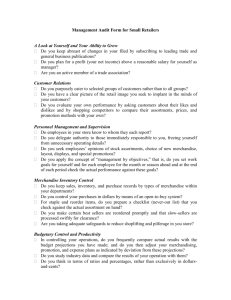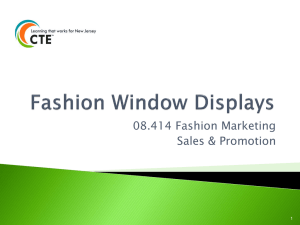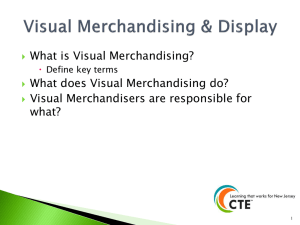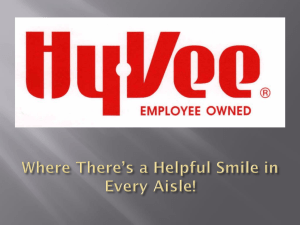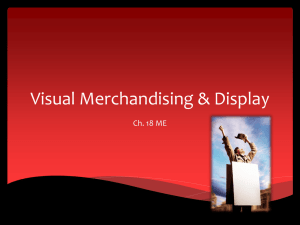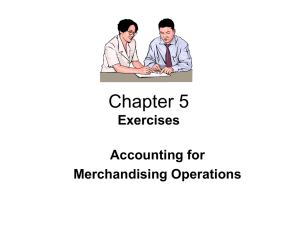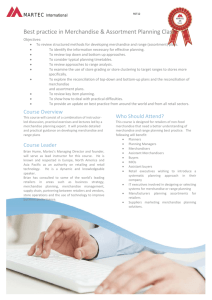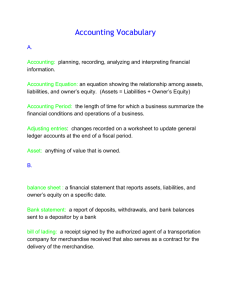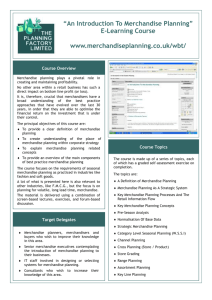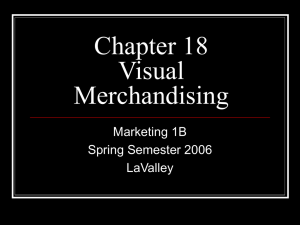Promotion & Visual Merchandising
advertisement
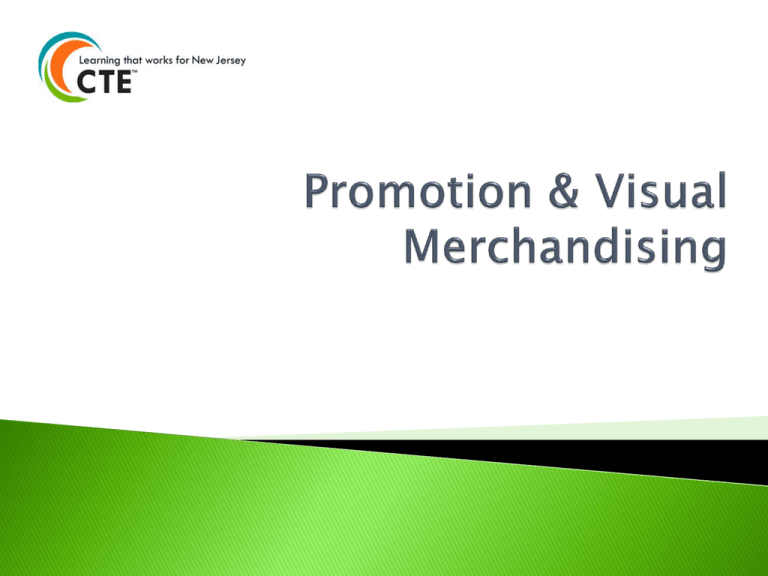
Promotion is the communication of information about goods, services, images and/or ideas to influence purchase behavior. 2 Personal and Non-personal Persuasive Relevant Suited to the product Factual Repetitious 3 Promotion links buyers and sellers Promotion influences purchase behavior Promotion allows sellers to communicate the benefits of their products to buyers Promotion is used to create demand for a product or service Promotion is a major element of the marketing mix 4 Advertising Visual Merchandising Sales Promotion Personal Selling Publicity 5 Businesses use a variety of communication techniques to give their promotional messages to consumers. The combination, or blend, of marketing communication channels that a business uses to send its messages to consumers is known as the promotional mix. 6 Key role in obtaining and keeping customers Appropriate blending of promotional elements enables businesses to communicate effectively with consumers. Promoters can inform potential customers about products, services, or ideas and persuade them to buy. 7 8 Presentation of merchandise to the customer in a visual way. ◦ This gives customers a firsthand view of the product. 9 To To To To To To sell goods show new uses for products introduce new goods build prestige and goodwill show proper care of merchandise suggest merchandise combinations 10 Promotional Displays – designed to sell the merchandise Institutional Displays – designed to promote community goodwill 11 The use of wires or strings to hang the merchandise in a display 12 Bow – the most important part because it’s seen the most, put current fashions and main merchandise in this area, designed to catch your eye Center Panel – runs from ceiling to floor Floor – used for tie-in items to help bring attention back to the window Back Wall/Side Wall – can be used to hang accessories, last thing seen in a display Door Wall – last chance for customer before entering the store 13 Primary – minimum amount of light necessary to the window without creating dark spots or shadows – lights up the whole display Secondary – lights up specific part of the display Atmosphere – creates an atmosphere 14 Play of light against shadow – moonlight (scary or romantic) Special lighting devices – black lights, etc. Colored lights and filters Wash lighting – entire scene flooded with light – creates a happy mood 15 Functional Props – display the merchandise (mannequin, Christmas tree, table, etc.) Decorative Props – establish a mood (snow, wood chips, leaves, etc.) Structural Props – change architectural organization of the window (ladder, polevertical, fence – horizontal) 16 Window – outside selling area Interior – inside selling area 17 Closed window design – uses a full background panel; completely separates the store’s interior from the window display Semi-closed window design – uses a half panel background to separate the store interior from the display. Potential customers can see over the displayed merchandise into the store. Open window design – make it possible for customers to look directly into the store. No back panel. 18 Island – Large, open tables stacked high with one or several types of merchandise and separated from surrounding areas End – Located at the end of merchandise aisles. Used for displaying timely & specially priced merchandise Platform – Merchandise displayed on stands raised above surrounding products. Shadow Box – Small closed interior displays built into walls or placed on counters or ledges Ledge – Shelves built on walls or other display units Point of Purchase – Open displays usually tied in with a manufacturer’s advertising program. Located in most cases near checkout counters or store exits. 19 Line – shortest distance between two points Direction – vertical, horizontal, oblique (diagonal), curvy Shape – circle, square, triangle, rectangle Size – blend sizes or contrast them) Space – every item should have its own space Texture – surface quality of an object (soft, hard, shiny, dull, rough, smooth) Weight – lightweight or heavyweight Color 20 Every object that you put into a display has all 8 of the design elements! 21 Triadic – Red, yellow, blue or Green, orange violet Advancing (warm) Red, orange, yellow Receding (cool) Blue, green violet Analogous (next to each other on the color wheel) Monochromatic (tints and shades of one color) Complementary – opposites (red/green, blue/orange, yellow/violet, etc.) Split Complementary – base and the colors around it Double Split Complementary – Base and colors around it and the complement and colors around it 22 Things every display must have! 23 Equal distribution of objects within the display ◦ Formal – mentally split the display down the center – both sides identical in space & weight visually ◦ Informal – both sides are balanced but not identical if split down the middle 24 First thing you see – the point of eye contact ◦ Ways to create a point of emphasis Contrasting Color Contrasting Shapes, sizes, textures Highlighting with spotlight Placement – putting something in the foreground 25 Blending and combining of everything in your display to create a pleasing effect 26 Arrangement of merchandise within a display 27 Pyramid – cylinder Step – Progression of sizes Zig Zag – background, middle-ground, foreground Repetition – Repeating or alternating items Radiation – (sun) emphasis is center and everything radiates from that. Rhythm – The way your eye moves through the display. (Rhythm will happen automatically if you have properly arranged merchandise.) Rhythm is the direction of your line. 28
